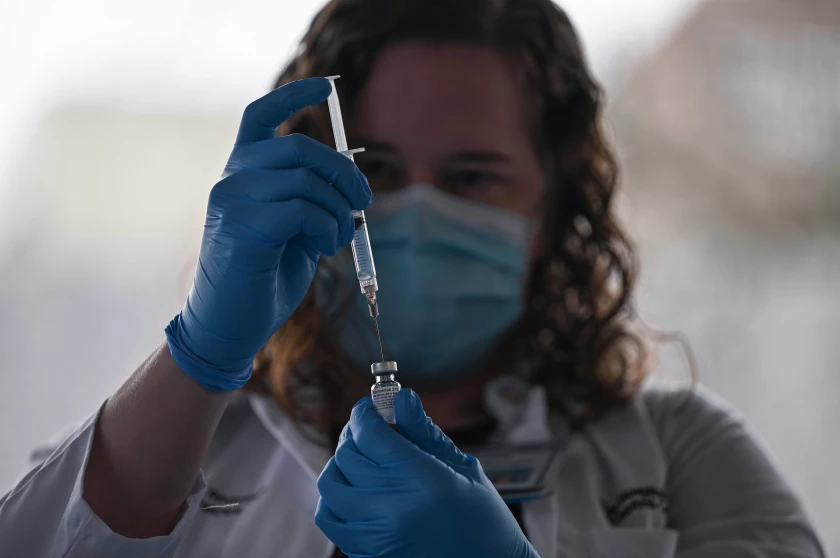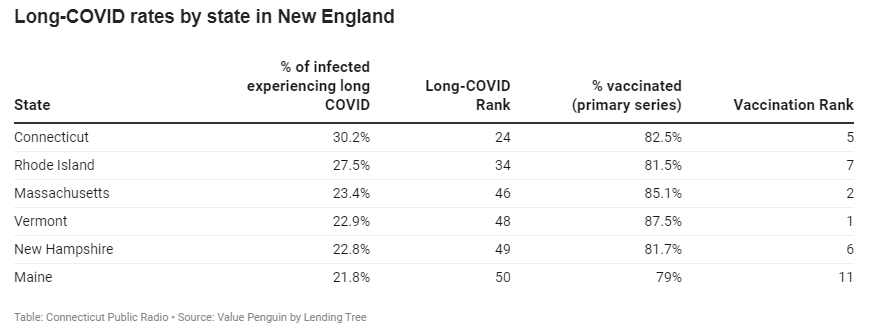Long COVID rates fall by half nationwide, New England rates among lowest

In December of 2020, Hartford HealthCare pharmacy manager Colleen Teevan prepared a Pfizer-BioNTech COVID-19 vaccine, among the first doses to be administered in Connecticut. (Ryan Caron King/Connecticut Public)
The number of people reporting long COVID symptoms fell by roughly half from last summer to 1 in 10, according to new data from the Centers for Disease Control and Prevention’s (CDC) Household Pulse Survey, analyzed by Kaiser Family Foundation (KFF).
Dr. Arjun Venkatesh, the incoming chair of emergency medicine at Yale School of Medicine, recently co-authored a study that found “people who are vaccinated were less likely to report symptoms three months after a COVID infection,” he said. “That’s not causal data. But, in general, it appears that people who are vaccinated seem to report fewer symptoms and less duration of symptoms.”
Another potential factor? A new, different study, also co-authored by Venkatesh, found that “the patients were more likely to report prolonged symptoms, if their initial COVID infection was in the pre Delta period, or the earliest sets of infections, and that it was less likely amongst those who’d had an Omicron variant infection,” he said.
Researchers could not pinpoint whether long COVID rates were definitively linked to the variant, vaccination and boosters or fewer external pandemic pressures – social isolation and loneliness. Venkatesh theorized that it’s most likely a combination.
According to the CDC survey data, among people who reported ever having had COVID-19, the percentage who said they currently – or have ever had – long COVID declined from 35% in June 2022 to 28% in January 2023.
Still, long COVID continues to be a top health concern. As of Jan. 16, 15% of all adults in the U.S. reported having had long COVID symptoms at some point, including 6% who still have symptoms.
Seventy-nine percent of people with ongoing long COVID reported limitations on their day-to-day activities, and 27% characterized the limitations as significant.
Frank Ziegler, a Tennessee-based attorney, has had long COVID for two years and is participating in Yale’s long COVID LISTEN study.
“I have shortness of breath, hand tremors and cognitive issues which include short-term memory issues and slower processing speeds,” he said.
Ziegler said he tested positive for COVID in January 2021, and his long COVID symptoms started in March that year – he was not vaccinated at the time since the rollout had not yet started for the general public.
Both Venkatesh and Dr. Ulysses Wu, an infectious disease expert at Hartford Hospital, said the trend is encouraging, but they offered caution.
“It’s positive findings that the percentages are decreasing,” Wu said. “But we still want to prevent people from getting COVID. And the best way to help with your long COVID is to not get COVID to begin with.”
Wu expects long COVID rates to increase if COVID rates start to climb.
New data on regional long COVID rates
A new study by health insurer Value Penguin by Lending Tree found that 30% of Connecticut residents who got COVID said their symptoms lasted three months or longer (long COVID). Connecticut ranks 24 out of 50 states for long COVID rates and has the fifth-highest rate of COVID vaccination at 82.5%.
Mississippi, Montana and Arkansas have the highest rate of long COVID – at least 35% of people who had COVID reported long COVID. Mississippi had a long COVID rate of 41.2%, Montana, 35.1% and Arkansas, 35%.
Maine, New Hampshire and Vermont have the lowest rate of long COVID – less than 23% of people who had COVID reported long COVID. Maine had a rate of 21.8%, New Hampshire, 22.8% and Vermont, 22.9%.

Table: Connecticut Public Radio (Source: Value Penguin by Lending Tree)
